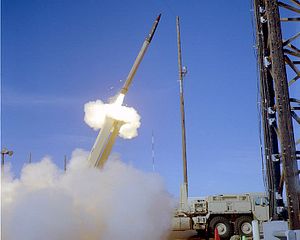China’s alarm over the U.S.-South Korean decision to deploy the Terminal High-Altitude Area Defense (THAAD) system hints at the creeping threat of an arms race in East Asia. Beijing is deeply concerned that, while the missile defense system is intended to safeguard against North Korean nuclear and ballistic missiles, its deployment may also weaken China’s deterrent capabilities. This development risks fueling the perception that the United States seeks to contain China and may provoke a forceful Chinese response.
Though anti-ballistic missiles systems are tactically defensive, historically they have been seen as strategically offensive weapons, as they undermine a state’s ability to retaliate in the event of nuclear coercion or war. On the surface, THAAD does not pose a direct threat to China’s deterrent. When the decision was unveiled the Department of Defense issued a statement claiming it was a “defensive measure” to protect against “North Korean nuclear and missile threats and would not be directed towards any third party nations.”
THAAD is intended for countering short to medium-range ballistic missiles attacks against alliance forces in the Korean peninsula. It is designed to intercept missiles in their terminal stage of flight. In this sense, it does not materially threaten China’s rocket force, as the Korean-based system would not be able to intercept any long-range missiles hypothetically launched at the United States.
Beijing’s concern instead lies in the possibility of integrating the system with other facets of a more robust missile defense network. THAAD’s radar could then relay launch data back to the U.S. homeland, improving the targeting of anti-ballistic missile systems. That such a capability might be used to penetrate Chinese territory has not gone unnoticed. Indeed, Chinese Foreign Minister Wang Yi was highly critical of the deployment, arguing it “far exceeds the Korean peninsula’s defense needs” and may “harm other countries’ legitimate security interests.” In particular, an improved U.S. ability to intercept or otherwise counter Chinese nuclear missiles directly undercuts the utility of China’s existing nuclear deterrent.
Since joining the nuclear club in 1964, Chinese defense planners have opted for the fewest number of nuclear weapons necessary to ensure a second-strike capability. According to the Department of Defense, the People’s Liberation Army Rocket Force maintains approximately 75 to 100 long-range nuclear missiles. Though well below the forces maintained by the United States and Russia, Beijing’s has long deemed them sufficient to provide an effective deterrent.
Historically, China has eschewed the doctrine of Mutually Assured Destruction, because it believed the threat of even a small nuclear retaliation was enough to deter nuclear war or coercion. Shy of a preemptive strike, it was unlikely a small Chinese nuclear force would be at risk of complete destruction. Even today, while some experts claim the United States has achieved nuclear primacy, even the survival of one or two weapons would ensure a devastating retaliation.
While few people can contemplate the use of nuclear weapons, it is important to remember that nuclear weapons are not only utilized to deter nuclear strikes. During the Cold War, the Soviet Union possessed an overwhelming conventional military advantage against NATO in Europe. In the face of such a threat, contemporary Western military planners were prepared to respond to a conventional war with a massive retaliation: up to and including nuclear strikes.
Today, the U.S.-China relationship is marked by the same imbalance of military forces, but this time to the advantage of the United States. While China maintains a “no first use” nuclear doctrine, the policy is by no means absolute. Specifically, PLA military officers have suggested nuclear weapons could be launched “if an enemy’s conventional attack threatened the survival of China’s nuclear force, or of the regime itself,” or even in response to a Taiwanese declaration of independence.
Beijing’s concern over missile defense might prompt it to pursue a much more aggressive security policy. This week, former South Korean Ambassador to China Kwon Young-se explained. “What China is really worried about is … Seoul’s potential joining in the U.S.-led regional missile defense network, not just THAAD deployment on the peninsula itself.” A concerted U.S. missile defense network in the Asia-Pacific would almost certainly threaten the viability of China’s currently minimal nuclear deterrence model. China is already working toward nuclear modernization and improving the survivability and reliability of its missiles. This year’s decision to promote the Second Artillery Corps provides further evidence of China’s increased commitment to strategic deterrence. Confronted with the very real possibility of a robust and effective missile defense system in the Asia-Pacific, China may take further steps to enlarge their force to compensate – and step on the slippery slope to an arms race with the United States.
Robert Cantelmo (@RobertCantelmo) is the Associate Director of the Center for the National Interest. He writes on U.S. national security and strategy.

































